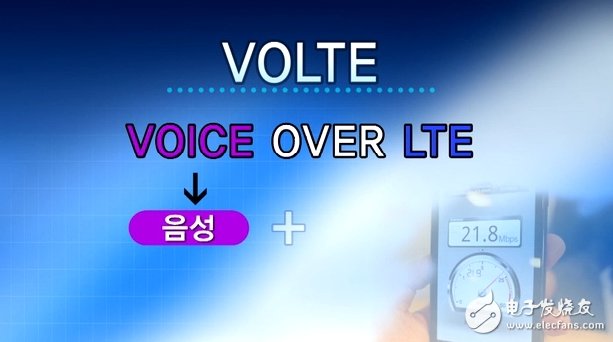Introduction : The 4G era has arrived. Experts analyze that voice services will continue to grow and have a large base in the 4G era. VoLTE technology was born. VoLTE technology is an end-to-end voice solution based on all-IP conditions on a 4G network. So what is his charm? The most direct feeling that VoLTE technology brings to 4G users is the shorter waiting time for connection and the higher quality and more natural audio and video call effect.
Yesterday in Chengdu, China Mobile Vice President Li Zhengmao successfully dialed the world ’s first 4G VoLTE high-definition audio and video phone through a 4G mobile phone, across TD-LTE and LTE FDD commercial networks. On the other side of the sea, South Korea, Cui Zhensheng, vice president of the country ’s largest telecommunications company SK Telecom, said in excitement in Chinese that he had just learned a long time ago: "Hello, Mr. Li, I heard your voice clearly and the picture Fluent. "
VoLTE, what industry technology controllers can only understand is entering our lives. What users care most about is how can VoLTE be used as a key technology component of 4G?

First, the operator's 4G network construction must deploy VoLTE technology on a large scale; second, the user's mobile phone must be a 4G mobile phone, and must be a multimode single standby terminal or a multimode dual standby terminal. Since 4G licenses have not been issued in China, 4G mobile phones have not yet been launched on a large scale. The four 4G mobile phones that were previously approved by the Ministry of Industry and Information Technology do not support VoLTE for the time being, because the TD-LTE 4G network has not yet deployed VoLTE on a large scale. The current solution is to upgrade the system software of 4G mobile phones to support VoLTE technical services.
So, when can users use VoLTE? China Mobile has also announced its commercial road sign at the same time as the VoLTE technical white paper released in the middle of this year, that is, to conduct technical trials in the third quarter of 2013, and commercial trials in the first half of 2014.
At present, South Korea's SK Telecom LG and U + have launched VoLTE commercial services based on the LTE FDD network. US operator Verizon is also expected to launch its first VoLTE mobile phone by the end of this year, and will expand the range of VoLTE commercial services in the first half of 2014. AT & T also announced that it has conducted VoLTE tests in some regions and will conduct preliminary market promotion by the end of this year. Sprint and T-Mobile America have been cautious about when to deploy VoLTE. At present, T-Mobile America has provided its users with so-called high-definition voice services.
Hongkong Telecom also announced the cooperation with Huawei to deploy VoLTE network technology in Hong Kong. According to the cooperation agreement, the two companies have successfully completed VoLTE network technology testing and will launch VoLTE services in Hong Kong by the end of 2013. The demonstration in Chengdu was also provided by Huawei with system solutions.
In the 4G era, although data services are an important weight for operators to generate revenue, voice services will continue to grow and have a large base, so voice services will still be an important source of cash flow for operators in the 4G era.
The relevant report predicts that from 2012 to 2018, the voice service on the mobile network will still account for 60% to 70% of the operator's revenue each year. With the advent of richer smartphones, more colorful voice service functions will be realized, which will also promote voice services in the 4G era.
What exactly is VoLTE?
VoLTE is Voice over LTE. It is an IP data transmission technology that does not require a 2G / 3G network. All services are carried on a 4G network, and data and voice services can be unified on the same network. In other words, the 4G network not only provides high-speed data services, but also provides high-quality audio and video calls. The latter requires VoLTE technology.
How is it different from making calls on 2G and 3G networks? The most direct feeling that VoLTE technology brings to 4G users is the shorter waiting time for connection and the higher quality and more natural audio and video call effect.

It is essentially different from 2G and 3G voice calls. VoLTE is an end-to-end voice solution based on all-IP conditions on a 4G network. Compared with 2G and 3G voice calls, VoLTE can improve voice quality by about 40% because it uses high-resolution codec technology. VoLTE brings users a lower access delay (waiting time after dialing), which is 50% lower than 3G, which is about 2 seconds, and 6-7 seconds in the 2G era. In addition, the drop rate of 2G and 3G occurs from time to time, but the drop rate of VoLTE is close to zero.
Not to mention the video call, the 2G and 3G era has failed to achieve. At present, it seems that VoLTE technology under 4G may change this status quo, but whether it can really be as popular as making voice calls in the future depends on China Mobile ’s 4G Network construction and coverage depth depend on the situation. Secondly, the video call environment also needs a certain amount of training time in China, after all, this is still a niche demand.
It should be noted that since 4G operators currently mainly use CSFB technology (a 4G voice solution), it means that 4G can fall back to 2G or 3G networks. Generally speaking, when there is no 4G signal or insufficient coverage, it will fall back to the 3G network. If 3G coverage is insufficient, it will fall back to the 2G network.
However, this solution requires that the baseband chip of the mobile phone terminal supports the CSFB algorithm. Although the overall design difficulty of the terminal is less than the dual standby solution (another 4G voice solution), its disadvantage is that it needs to transform the 3G / 2G network and optimize the LTE network. Put forward higher requirements, will affect the LTE network deployment speed to a certain extent.
Therefore, the initial CSFB and dual standby are both transitional technologies developed for VoLTE evolution, and will coexist with VoLTE for a period of time. Among them, under the premise of supporting international roaming, the life cycle of CSFB will be relatively long, and at the same time, the dual standby solution will exist for a long time as a terminal form. Overall, under 4G, VoLTE will not completely replace 2G and 3G voice calls.
Zoom Camera , Thermal Camera ,Drone searching Light, Drone Mega Phone,Drone Survey Gimbals
Zoom Camera, Thermal Camera,Drone searching Light, Drone Mega Phone,Drone Survey Gimbals
shenzhen GC Electronics Co.,Ltd. , https://www.jmrdrone.com
